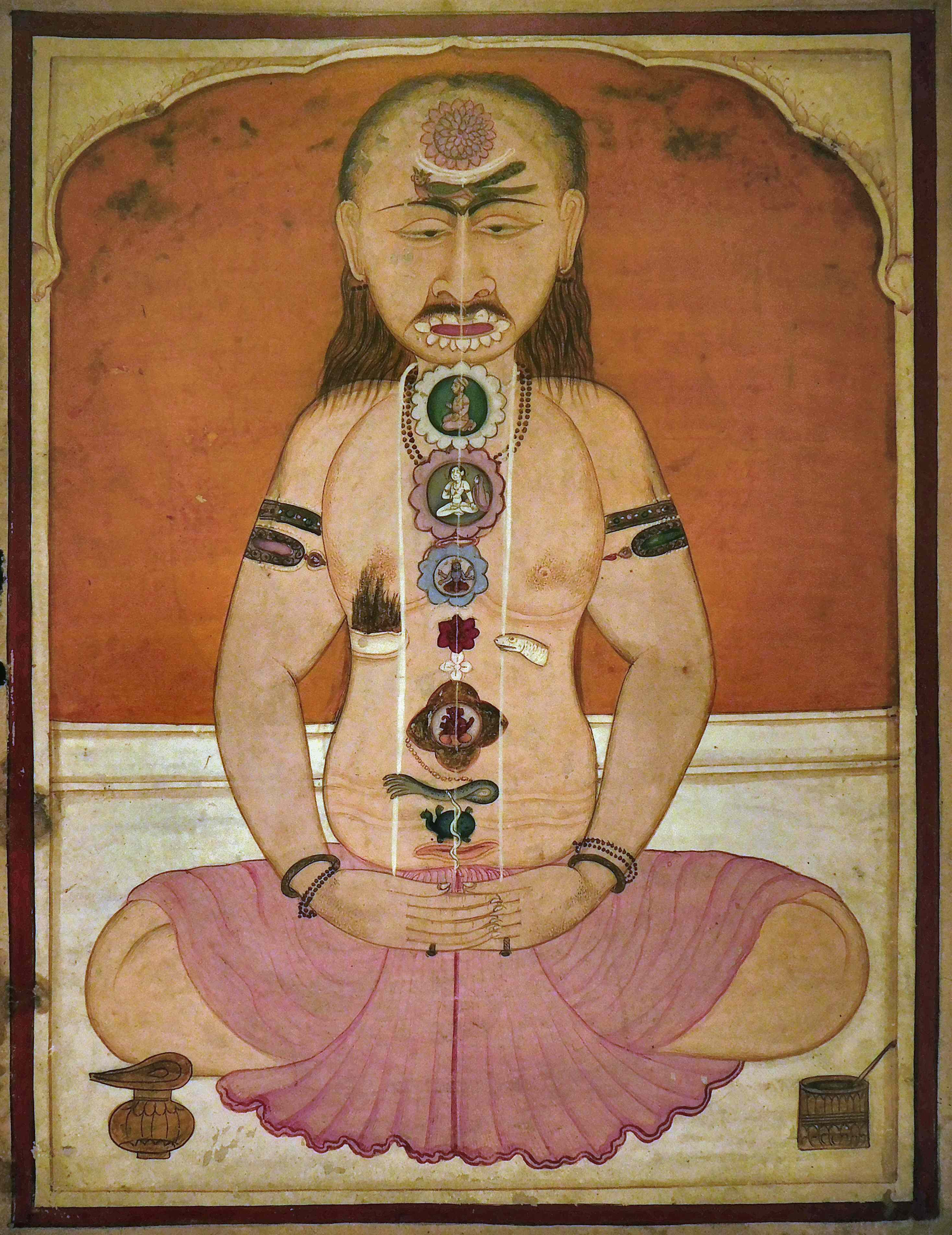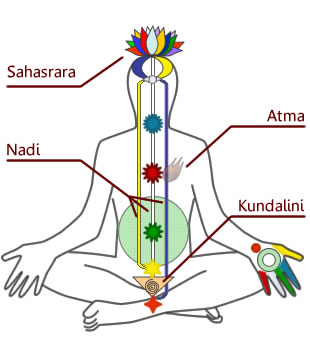|
Bhastrika
Bhastrikā is an important breath exercise in yoga and pranayama. It is sometimes treated as a kriya or 'cleansing action' along with kapalabhati to clear the airways in preparation for other pranayama techniques. Bhastrika involves a rapid and forceful process of inhalation and exhalation powered by the movement of the diaphragm. The movement of air is accompanied by an audible sound. One inhale and exhale equals one round of bhastrika, and it may be repeated for many consecutive rounds. B. K. S. Iyengar explains that the similar "process or kriyā of ''kapālabhāti'' is a milder form of Bhastrikā Prāṇāyāma. Swami Sivananda describes the process: "inhale and exhale quickly ten times like the bellows of the blacksmith. Constantly dilate and contract. When you practise this Pranayama a hissing sound is produced. The practitioner should start with rapid expulsions of breath following one another in rapid succession. When the required number of expulsions, say ten for a round, ... [...More Info...] [...Related Items...] OR: [Wikipedia] [Google] [Baidu] |
Kapalabhati Pranayama
Kapalabhati ( sa, कपालभाति, kapālabhāti, "Skull-polishing") is an important shatkarma, a purification in hatha yoga. The word kapalabhati is made up of two Sanskrit words: ''kapāla'' meaning "skull", and ''bhāti'' meaning "shining, illuminating". It is intended mainly for cleaning the sinuses but according to the ''Gheranda Samhita'' has magical curative effects. in ''Yoga Magazine'', a publication of . There are three forms of Kapalabhati: * ''Vatakrama'', a practice similar to the |
Kapalabhati (Hatha Yoga)
Kapalabhati ( sa, कपालभाति, kapālabhāti, "Skull-polishing") is an important shatkarma, a purification in hatha yoga. The word kapalabhati is made up of two Sanskrit words: ''kapāla'' meaning "skull", and ''bhāti'' meaning "shining, illuminating". It is intended mainly for cleaning the sinuses but according to the '' Gheranda Samhita'' has magical curative effects. in ''Yoga Magazine'', a publication of Bihar School of Yoga. There are three forms of Kapalabhati: * ''Vatakrama'', a practice similar to the technique of |
Pranayama
Pranayama is the yogic practice of focusing on breath. In Sanskrit, '' prana'' means "vital life force", and ''yama'' means to gain control. In yoga, breath is associated with ''prana'', thus, pranayama is a means to elevate the '' prana'' ''shakti'', or life energies. Pranayama is described in Hindu texts such as the ''Bhagavad Gita'' and the ''Yoga Sutras of Patanjali''. Later in Hatha yoga texts, it meant the complete suspension of breathing. Etymology ''Prāṇāyāma'' (Devanagari: ') is a Sanskrit compound. It is defined variously by different authors. Macdonell gives the etymology as prana ('), breath, + ''āyāma'' and defines it as the suspension of breath. Monier-Williams defines the compound ' as "of the three 'breath-exercises' performed during (''See'' ', ', '". This technical definition refers to a particular system of breath control with three processes as explained by Bhattacharyya: ' (to take the breath inside), ' (to retain it), and ' (to discharge i ... [...More Info...] [...Related Items...] OR: [Wikipedia] [Google] [Baidu] |
Yoga
Yoga (; sa, योग, lit=yoke' or 'union ) is a group of physical, mental, and spiritual practices or disciplines which originated in ancient India and aim to control (yoke) and still the mind, recognizing a detached witness-consciousness untouched by the mind ('' Chitta'') and mundane suffering (''Duḥkha''). There is a wide variety of schools of yoga, practices, and goals in Hinduism, Buddhism, and Jainism,Stuart Ray Sarbacker, ''Samādhi: The Numinous and Cessative in Indo-Tibetan Yoga''. SUNY Press, 2005, pp. 1–2.Tattvarthasutra .1 see Manu Doshi (2007) Translation of Tattvarthasutra, Ahmedabad: Shrut Ratnakar p. 102. and traditional and modern yoga is practiced worldwide. Two general theories exist on the origins of yoga. The linear model holds that yoga originated in the Vedic period, as reflected in the Vedic textual corpus, and influenced Buddhism; according to author Edward Fitzpatrick Crangle, this model is mainly supported by Hindu scholars. According ... [...More Info...] [...Related Items...] OR: [Wikipedia] [Google] [Baidu] |
Shatkarma
The shatkarmas (Sanskrit: षटकर्म ''ṣaṭkarma'', literally ''six actions''), also known as shatkriyas,Shatkarmas - Cleansing Techniques in Yoga Magazine, a publication of Bihar School of Yoga are a set of purifications of the body, to prepare for the main work of yoga towards (liberation). These practices, outlined by Svatmarama in the '' |
Light On Yoga
''Light on Yoga: Yoga Dipika'' (Sanskrit: योग दीपिका, "Yoga Dīpikā") is a 1966 book on the Iyengar Yoga style of modern yoga as exercise by B. K. S. Iyengar, first published in English. It describes more than 200 yoga postures or asanas, and is illustrated with some 600 monochrome photographs of Iyengar demonstrating these. The book has been described as the 'bible of modern yoga', and its presentation of the asanas has been called "unprecedented" and "encyclopedic". It has been translated into at least 23 languages and has sold over three million copies. Context Yoga is a group of physical, mental, and spiritual practices from ancient India, forming one of the six orthodox schools of Hindu philosophical traditions. In the Western world, however, yoga is often taken to mean a modern form of medieval Hatha yoga, practised mainly for exercise, consisting largely of the postures called asanas. B. K. S. Iyengar (1918-2014) was born in a poor family ... [...More Info...] [...Related Items...] OR: [Wikipedia] [Google] [Baidu] |
Swami Sivananda
Sivananda Saraswati (or Swami Sivananda; 8 September 1887 – 14 July 1963) was a yoga guru, a Hindu spiritual teacher, and a proponent of Vedanta. Sivananda was born Kuppuswami in Pattamadai, in the Tirunelveli district of Tamil Nadu. He studied medicine and served in British Malaya as a physician for several years before taking up monasticism. He was the founder of the Divine Life Society (DLS) in 1936, Yoga-Vedanta Forest Academy (1948) and author of over 200 books on yoga, Vedanta, and a variety of subjects. He established Sivananda Ashram, the headquarters of the DLS, on the bank of the Ganges at Muni Ki Reti, from Rishikesh, and lived most of his life there. Sivananda Yoga, the yoga form propagated by his disciple Vishnudevananda, is now spread in many parts of the world through Sivananda Yoga Vedanta Centres. These centres are not affiliated with Sivananda's ashrams, which are run by the Divine Life Society. Biography Early life Swami Sivananda was born as Ku ... [...More Info...] [...Related Items...] OR: [Wikipedia] [Google] [Baidu] |
Sivananda Saraswati
Sivananda Saraswati (or Swami Sivananda; 8 September 1887 – 14 July 1963) was a yoga guru, a Hindu spiritual teacher, and a proponent of Vedanta. Sivananda was born Kuppuswami in Pattamadai, in the Tirunelveli district of Tamil Nadu. He studied medicine and served in British Malaya as a physician for several years before taking up monasticism. He was the founder of the Divine Life Society (DLS) in 1936, Yoga-Vedanta Forest Academy (1948) and author of over 200 books on yoga, Vedanta, and a variety of subjects. He established Sivananda Ashram, the headquarters of the DLS, on the bank of the Ganges at Muni Ki Reti, from Rishikesh, and lived most of his life there. Sivananda Yoga, the yoga form propagated by his disciple Vishnudevananda, is now spread in many parts of the world through Sivananda Yoga Vedanta Centres. These centres are not affiliated with Sivananda's ashrams, which are run by the Divine Life Society. Biography Early life Swami Sivananda was born as K ... [...More Info...] [...Related Items...] OR: [Wikipedia] [Google] [Baidu] |
Hatha Yoga Pradipika
The ''Haṭha Yoga Pradīpikā'' ( or Light on Hatha Yoga) is a classic fifteenth-century Sanskrit manual on haṭha yoga, written by Svātmārāma, who connects the teaching's lineage to Matsyendranath of the Nathas. It is among the most influential surviving texts on haṭha yoga, being one of the three classic texts alongside the '' Gheranda Samhita'' and the ''Shiva Samhita''. More recently, eight works of early hatha yoga that may have contributed to the ''Hatha Yoga Pradipika'' have been identified. Title and composition Different manuscripts offer different titles for the text, including ''Haṭhayogapradīpikā'', ''Haṭhapradīpikā'', ''Haṭhapradī'', and ''Hath-Pradipika''. It was composed by Svātmārāma in the 15th century as a compilation of the earlier haṭha yoga texts. Svātmārāma incorporates older Sanskrit concepts into his synthesis. He introduces his system as a preparatory stage for physical purification before higher meditation or Raja Yoga. ... [...More Info...] [...Related Items...] OR: [Wikipedia] [Google] [Baidu] |
Kundalini
In Hinduism, Kundalini ( sa, कुण्डलिनी, translit=kuṇḍalinī, translit-std=IAST, lit=coiled snake, ) is a form of divine feminine energy (or ''Shakti'') believed to be located at the base of the spine, in the ''muladhara''. It is an important concept in Śhaiva Tantra, where it is believed to be a force or power associated with the divine feminine or the formless aspect of the Goddess. This energy in the body, when cultivated and awakened through tantric practice, is believed to lead to spiritual liberation. Kuṇḍalinī is associated with Parvati or Adi Parashakti, the supreme being in Shaktism; and with the goddesses Bhairavi and Kubjika. The term, along with practices associated with it, was adopted into Hatha yoga in the 9th century. It has since then been adopted into other forms of Hinduism as well as modern spirituality and New Age, New age thought. Kuṇḍalinī awakenings are said to occur by a variety of methods. Many systems of yoga focus o ... [...More Info...] [...Related Items...] OR: [Wikipedia] [Google] [Baidu] |
Kundalini Energy
In Hinduism, Kundalini ( sa, कुण्डलिनी, translit=kuṇḍalinī, translit-std=IAST, lit=coiled snake, ) is a form of divine feminine Energy (esotericism), energy (or ''Shakti'') believed to be located at the base of the spine, in the ''Muladhara (Root Chakra), muladhara''. It is an important concept in Shaivism#Grihastha and Sannyasi Shaiva: Mantramarga, Śhaiva Tantra, where it is believed to be a force or power associated with the Devi, divine feminine or the formless aspect of the Goddess. This energy in the body, when cultivated and awakened through Tantra, tantric practice, is believed to lead to Moksha, spiritual liberation. Kuṇḍalinī is associated with Parvati or Adi Parashakti, the supreme being in Shaktism; and with the goddesses Bhairavi and Kubjika. The term, along with practices associated with it, was adopted into Hatha yoga in the 9th century. It has since then been adopted into other forms of Hinduism as well as modern spirituality and New A ... [...More Info...] [...Related Items...] OR: [Wikipedia] [Google] [Baidu] |
Wim Hof
Wim Hof (; born 20 April 1959), also known as The Iceman, is a Dutch motivational speaker and extreme athlete noted for his ability to withstand low temperatures. He previously held a Guinness World Record for swimming under ice and prolonged full-body contact with ice, and holds a record for a barefoot half marathon on ice and snow. He attributes these feats to his Wim Hof Method (WHM), a combination of frequent cold exposure, breathing techniques and meditation. Hof has been the subject of several medical assessments and The New York Times bestselling book ''What Doesn't Kill Us'' written by investigative journalist Scott Carney. Personal life Wim Hof was born in Sittard, Limburg, Netherlands, one of nine children. Hof met his first wife Marivelle-Maria, also called “Olaya Rosino Fernandez” (born in 1960, from Basque Country, Spain) in the Vondelpark in Amsterdam in the garden of roses. She died by suicide in 1995 by jumping from an eight-story building. She was diagnose ... [...More Info...] [...Related Items...] OR: [Wikipedia] [Google] [Baidu] |





